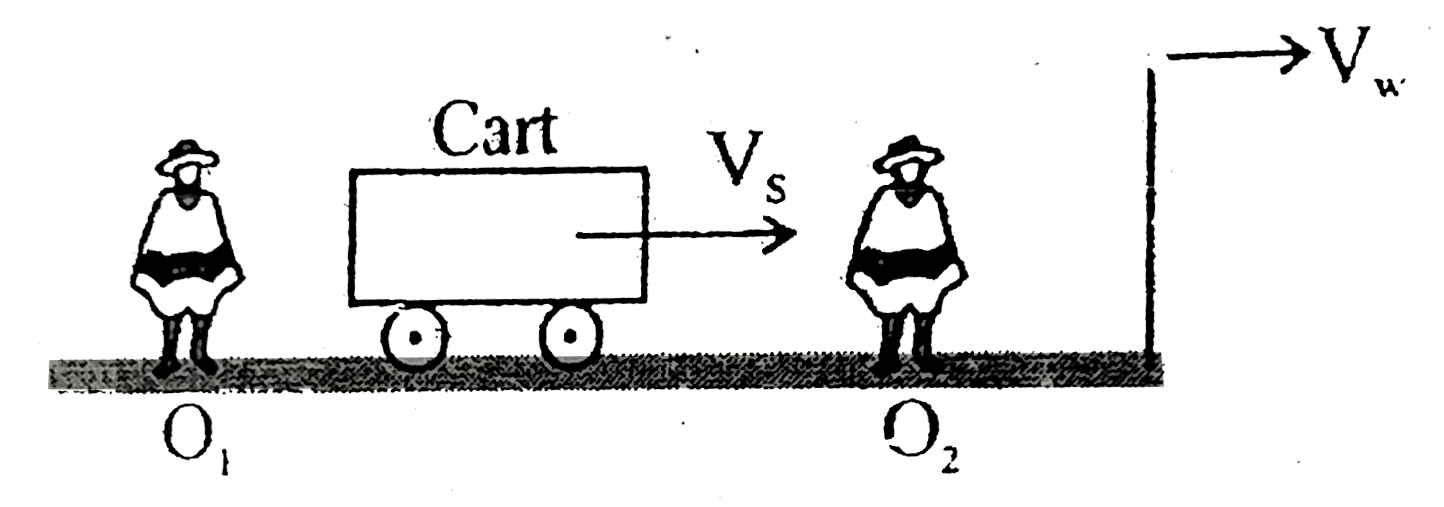Match Column-I with Column-II :
Column-IColumn-II(1) If A and B are moving perpendicular to each other than velocity of w.r.t. B.(a)vrm=vr−vm(2) Relative velocity of rain drop w.r.t to man(b)vAB=vA+vB(c)vAB=√v2A+v2BSolution in Gujrati
The correct Answer is:(1-c), (2-a)
Step by step video, text & image solution for Match Column-I with Column-II : {:("Column-I","Column-II"),("(1) If A and B are moving perpendicular to each other than velocity of w.r.t. B.",(a)v_(rm)=v_r-v_m),("(2) Relative velocity of rain drop w.r.t to man",(b) v_(AB)=v_A+v_B),(,(c) v_(AB)=sqrt(v_(A)^2+v_(B)^2)):} by Physics experts to help you in doubts & scoring excellent marks in Class 11 exams.
Updated on:21/07/2023Topper's Solved these Questions
- OBJECTIVE QUESTIONS AS PER NEW PAPER STYLE BOOK - KUMAR PRAKASHANCHAPTER - OBJECTIVE QUESTIONS AS PER NEW PAPER STYLE EXERCISE - CHAPTER - 4 (Fill in the Blanks)
10 Videos
- OBJECTIVE QUESTIONS AS PER NEW PAPER STYLE BOOK - KUMAR PRAKASHANCHAPTER - OBJECTIVE QUESTIONS AS PER NEW PAPER STYLE EXERCISE - CHAPTER - 4 (Are the following statements True or False ? )
10 Videos
- OBJECTIVE QUESTIONS AS PER NEW PAPER STYLE BOOK - KUMAR PRAKASHANCHAPTER - OBJECTIVE QUESTIONS AS PER NEW PAPER STYLE EXERCISE - CHAPTER - 3 (Are the following statements True or False ? )
10 Videos
- MOTION IN A STRAIGHT LINE BOOK - KUMAR PRAKASHANCHAPTER - MOTION IN A STRAIGHT LINE EXERCISE - QUESTION PAPER
11 Videos
- OSCILLATIONSBOOK - KUMAR PRAKASHANCHAPTER - OSCILLATIONSEXERCISE - QUESTION PAPER (SECTION - D)
1 Videos
Similar Questions
If →A⋅→B=AB, then angle between →Aand→B will be …... .
View Solutionˆiandˆj are unit vector along x-axis and y-axis respectively.Find the resultant vector.
View SolutionAn object have zero velocity even then it has acceleration.
View SolutionDefine frame of reference and give its types.
View SolutionA cylindrical piece of cork of density of base area A and height h floats in a liquid of density pl. The cork is depressed slightly and then released. Show that the cork oscillates up and down simple harmonically with a period
T=2π√hpp1g
where p is the density of cork. (Ignore damping due to viscosity of the liquid).
View SolutionThree concentric spherical metallic shells A, B, and C of radii a,b, and c(a lt b lt c) have surface charge densities sigma, -sigma and sigma , respectively. If V_(A), V_(B) and V_(C) are potential of shells A, B and C, respectively, match the columns {:("Column A",,,"Column B"),(a. V_(A),,i.,sigma/epsilon_(0)[(a^(2)-b^(2)+c^(2))/c]),(b. V_(B),,ii.,sigma^(2)/epsilon_(0)[a^(2)/b-b+c]),(c. V_(C),,iii.,sigma/epsilon_(0)[a-b+c]):}
View Solutionomega_(AB)=("Relative velocity of A w.r.t. B perpendicular to line AB")/("Sepration between a and B") |(vec(v)_(AB))_(bot)|=v_(A) sin theta_(1)+v_(B) sin theta_(2) r_(AB)=r omega_(AB)=(v_(A) sin theta_(1)+v_(B) sin theta_(2))/(r) (v_(AB))_(11)=v_(A) cos theta_(1)-v_(B) cos theta_(2) (v_(AB))_(11) gt 0." " Then A will approach B (v_(AB))_(11) lt 0. " " Then B will separate from A
View Solution
Observers O1andO2 are at rest and the wall is moving with velocity V_(w) Cart is moving with constant velocity V_(s) towards wall. The source of sound is in the cart, the original frequency of the wave is f. sound has velocity C w.r.t. ground (medium is stationary) Then match the column -I with column-II
Column-IColumn-II(A)Wavelength received byO1directly from cart(P)(C−VwC+Vw)(C−Vs)f(B)Wavelength received byO2directly from cart(Q)C+Vsf(C)Wavelength received by driver of the cartafter reflection from wall(R)(C+VwC−Vw)(C−Vs)f(D)Wavelength received byreflection from wallO1after(S)C−Vsf(T)None of these
View SolutionMatch Column - I with Column-II:
Column-I(Ideal Gas)Column-II(Related equation)(A)Reversible isothermal process(P)W = 2.303nRT log(P2/P1)(B)Reversible adiabatic process (Q)W=nCVm(T2−T1)(C)Irreversible adiabatic process(R)W = -2.303nRT log(V2/V1)(D)Irreversible isothermal process (S)W=−∫VfViPext.dV
View SolutionTwo objects A and B are moving in opposite directions with velocities v_(A) and v_(B) respectively, the magnitude of relative velocity of A w.r.t. B is
View Solutionकिसी कण के सापेक्ष वेग क्या अभिप्राय है ? दो कण A तथा B एक सीधी सड़क पर एक ही दिशा में क्रमश :vA एवं vB वेग में गतिशील हैं। दिखाइए कि कण A का कण B के सापेक्ष वेग vAB=vA−vB.
View Solutionयदि वस्तु A का वेग v1तथा वस्तु B का वेग →v2हो तो A के सापेक्ष B का आपेक्षिक वेग तथा B के सापेक्ष A का आपेक्षिक वेग ज्ञात कीजिए |
View SolutionIf A and B persons are moving with VA and VB velocities directions. Magnitude of relative velocity of B w.r.t. A is a x and magnitude of relative velocity of A w.r.t. B is y. Then
View Solutionf A and B persons are moving with VAandVB. velocities in opposite directions. Magnitude of relative velocity of B w.r.t. A is x and magni-tude of relative velocity of A w.r.t B is y. Then
View SolutionIn Column-I relaion and in Column-II corresponding equation is given. Match them properly : {:("Column-I","Column-II"),((1) Velocity rarr relation,(a)v=v_0+at),((2) Velocity rarr "displacement relation",(b)S=v_0t+1/2at^2),(,(c) v^2=v_(0)^2+2as):}
View Solution
